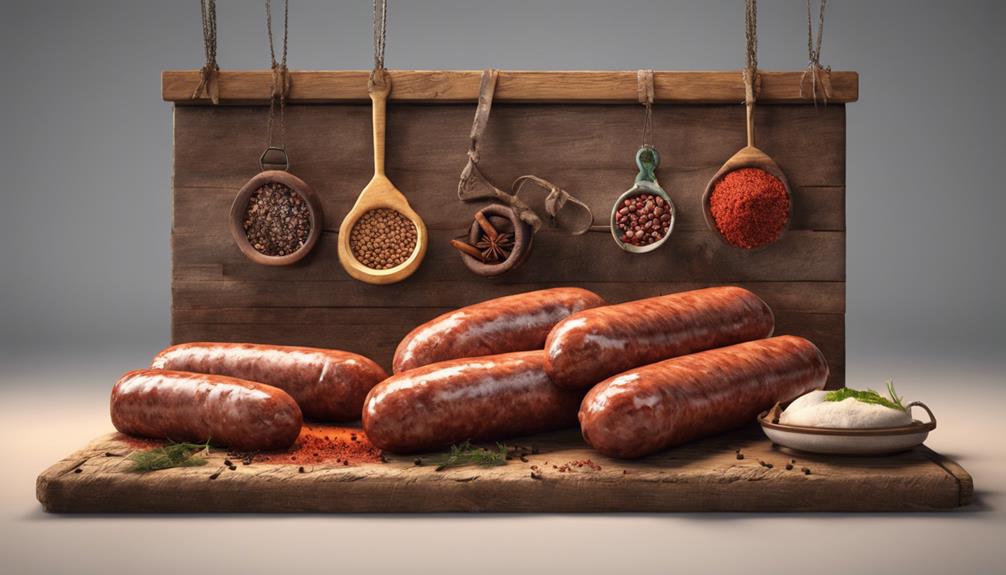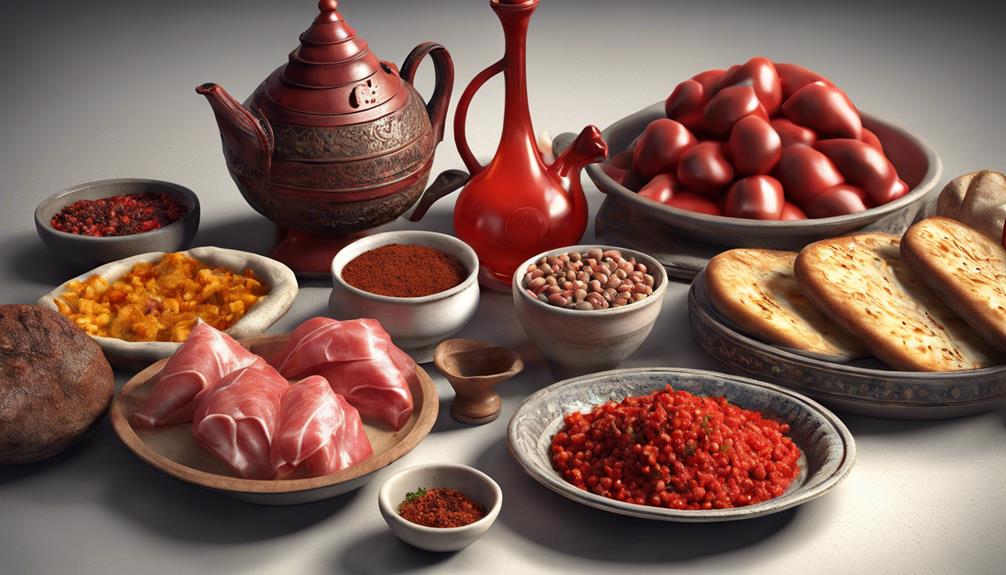Curious about the captivating blend of spices and cultural significance that make Turkish sausage, sucuk, a standout? Explore the unique features that set it apart.
 Add to Recipe Book
Add to Recipe BookWhen it comes to Turkish sausage, sucuk, there are some intriguing aspects that set it apart from other sausages you might have encountered. The blend of spices used, the meticulous curing process, and the cultural significance all contribute to the unique flavor and texture of sucuk. But there’s more to discover about the distinct features that make Turkish sausage a standout in the world of charcuterie.
History of Turkish Sausage

Exploring the origins of Turkish sausage reveals a rich culinary tradition intertwined with the country’s history and cultural influences. Turkish sausage, known as sucuk, holds a significant place in Turkish cuisine, with a history dating back centuries. Its origins can be traced to the Ottoman Empire, where it was a staple for soldiers due to its long shelf life and high protein content.
The historical significance of Turkish sausage lies in its evolution of making techniques. Initially, sucuk was crafted using traditional methods such as hand-mincing the meat, mixing it with spices like garlic, cumin, and sumac, and stuffing it into natural casings. Over time, these techniques have been refined and adapted to modern production processes, ensuring the quality and consistency of Turkish sausage.
The evolution of Turkish sausage making techniques reflects the innovation and adaptability of Turkish culinary practices. With advancements in technology and food preservation methods, the production of sucuk has become more efficient while still honoring the traditional flavors and craftsmanship.
Today, Turkish sausage continues to be a beloved delicacy enjoyed in various dishes like breakfasts, kebabs, and mezes, showcasing the enduring legacy of this flavorful and versatile ingredient in Turkish cuisine.
Ingredients and Spices Used
Various traditional spices and quality ingredients are key elements in crafting the distinctive flavor of Turkish sausage, sucuk. Seasoning blends play a pivotal role in giving sucuk its unique taste, with each region in Turkey having its own variations.
Common spices used in sucuk include garlic, cumin, sumac, and red pepper flakes. These spices are carefully selected and blended to create a perfect harmony of flavors that are both savory and slightly tangy.
The spice combinations used in sucuk vary slightly depending on the region, with some areas adding a touch of paprika or fenugreek to enhance the overall taste profile. These traditional flavors have been passed down through generations, with each family often having their secret blend of spices that make their sucuk stand out.
In addition to spices, high-quality ingredients such as ground beef or lamb, and sometimes a mix of both, are essential for making sucuk. The meat is typically mixed with salt and the seasoning blend, then stuffed into a casing before being left to cure.
The careful selection of ingredients ensures that sucuk has a rich and robust flavor that’s a staple in Turkish cuisine.
Curing and Aging Process

To further enhance the flavors and texture of Turkish sausage, sucuk, the curing and aging process plays a significant role in the final taste profile and quality of the product. Traditional techniques are often employed in the curing process of Turkish sausage, where a mixture of ground meat, garlic, salt, and a blend of unique spices is stuffed into a casing and left to ferment. This fermentation process is vital as it allows the flavors to develop and intensify.
The aging process is where the magic truly happens. During this time, which can range from a few weeks to several months, the sucuk is left to dry and mature. Traditional methods involve hanging the sausages in a controlled environment to allow for natural fermentation and drying. However, modern innovations have introduced controlled aging chambers that regulate temperature and humidity to guarantee a consistent and safe aging process.
As the sucuk ages, enzymes break down the proteins in the meat, resulting in a tender and flavorful sausage. The aging process also allows the spices to meld together, creating a harmonious blend of flavors. Different aging times will produce varying flavor profiles, with some sucuks developing a more intense and complex taste, while others maintain a milder flavor profile. Ultimately, the curing and aging process is what gives Turkish sausage its unique and distinct taste that’s cherished by many.
Varieties of Turkish Sausage
Discover the diverse array of Turkish sausage varieties that showcase unique flavors and ingredients. Turkish sausages come in a wide range of flavor variations, each offering a distinct taste profile that reflects the regional specialties of the area it originates from. From spicy and bold to mild and aromatic, there’s a Turkish sausage variety to suit every palate.
Popular pairings with Turkish sausages include traditional accompaniments like fresh bread, olives, cheese, and pickles. These pairings enhance the flavors of the sausage and create a well-rounded meal. Turkish sausages are also commonly used in various cooking techniques such as grilling, pan-frying, or incorporating them into stews and casseroles. Each cooking method brings out different aspects of the sausage’s unique taste.
When it comes to regional specialties, Turkish sausages vary greatly depending on the area they’re produced in. For example, Sucuk is a popular spicy sausage that hails from the Black Sea region, while Sucuk is a milder variety commonly found in the Aegean region. These regional differences result in a rich tapestry of flavors and textures that make Turkish sausages a truly diverse culinary experience. Whether enjoyed on their own or as part of a larger meal, Turkish sausages offer a delicious taste of Turkey’s gastronomic heritage.
Cooking Methods and Recipes

Explore the best cooking methods and delicious recipes to elevate your experience with Turkish sausages. When it comes to Turkish sausages, grilling techniques are a popular choice to enhance their rich flavors. The smoky char from the grill adds an extra dimension to the already robust taste of the sausage. Additionally, trying out innovative recipes can take your Turkish sausage dishes to the next level. Incorporating unexpected ingredients or cooking methods can surprise your taste buds in the most invigorating way possible.
To make the most out of your Turkish sausages, consider these flavor pairings and unique preparations:
| Grilling Techniques | Innovative Recipes | Flavor Pairings | Unique Preparations |
|---|---|---|---|
| Grill the sausages over medium heat, turning occasionally until they are evenly cooked and have beautiful grill marks. | Try making a Turkish sausage stir-fry with bell peppers, onions, and a splash of pomegranate molasses for a sweet and tangy twist. | Pair Turkish sausages with fresh Mediterranean salads for a revitalizing contrast to the savory flavors. | Create a Turkish sausage and eggplant casserole baked with a creamy yogurt sauce for a comforting meal with a Turkish twist. |
Experimenting with these cooking methods and recipes will allow you to fully appreciate the unique qualities of Turkish sausages while adding a creative touch to your culinary repertoire.
Regional Influences on Flavor
Let’s explore how the diverse regions of Turkey contribute to the unique flavor profiles of Turkish sausage. Different areas infuse their cultural influences into the sausage-making process, resulting in a wide range of taste experiences. Understanding these regional nuances sheds light on the rich tapestry of Turkish culinary traditions.
Flavor Profiles by Region
Different regions in Turkey offer unique flavor profiles in their sausages, influenced by local ingredients and traditional cooking methods. When it comes to sucuk seasoning, taste variations are abundant across the country.
In the Black Sea region, sausages are characterized by a bold and earthy taste, often incorporating garlic and a mix of regional spices. Moving towards the Aegean coast, you’ll find sausages with a lighter and more citrusy flavor profile, thanks to the abundant use of lemon zest and Mediterranean herbs.
In the southeastern region of Turkey, near the Syrian border, sausages boast a spicy kick with the addition of sumac and red pepper flakes. On the other hand, in central Anatolia, sausages are known for their robust and smoky flavors, attributed to the use of cumin and paprika in the seasoning mix.
Each region’s unique climate, soil, and culinary traditions play a significant role in shaping the distinct flavor profiles of Turkish sausages, making them a diverse and exciting culinary experience.
Cultural Ingredient Influences
Regional influences play an essential role in shaping the flavor profiles of Turkish sausages. Each area contributes unique cultural ingredients that define the taste of sucuk in that specific locality. Cultural traditions deeply rooted in various regions influence the choice of ingredients used in making sucuk.
For instance, in the Black Sea region, where nuts are abundant, you’ll find sucuk flavored with a nuttier profile compared to other areas. Ingredient sourcing is vital as well, with regions known for specific spices or herbs incorporating them into their sausage recipes, adding a distinct regional flair.
Culinary fusion also plays a significant role, where traditional customs meet modern influences, resulting in innovative sucuk variations. This blending of old and new techniques creates a diverse range of flavors across Turkey, showcasing the rich tapestry of the country’s culinary heritage.
Health Benefits of Sucuk

Sucuk, a type of Turkish sausage, offers various health benefits due to its unique blend of spices and high protein content. The cooking techniques used in preparing sucuk help retain its nutritional value, making it a healthier option compared to other processed meats.
Sucuk is packed with protein, which is essential for muscle growth and repair. Additionally, it contains a variety of spices like garlic, cumin, and paprika, which have antioxidant and anti-inflammatory properties. These spices not only enhance the flavor but also contribute to the important benefits of sucuk.
In terms of nutritional value, sucuk is a good source of iron, zinc, and vitamin B12. Iron is vital for oxygen transport in the body, zinc supports the immune system, and vitamin B12 is necessary for nerve function and DNA synthesis. When preparing sucuk, opt for grilling or baking instead of frying to reduce the overall fat content.
To make the most of the health benefits of sucuk, consider pairing it with fresh vegetables and whole grains to create a balanced meal. You can also try incorporating sucuk into dishes like omelets, salads, or pasta for a flavorful twist. By being mindful of portion sizes and choosing healthier cooking methods, sucuk can be enjoyed as part of a nutritious diet.
Serving and Pairing Suggestions
Enhance your culinary experience with sucuk by exploring creative serving and pairing suggestions that complement its rich flavors. When it comes to enjoying sucuk, there are various ways to elevate your dining experience.
Here are some suggestions to inspire you:
- Tasting Events: Attend tasting events dedicated to Turkish cuisine where you can sample different varieties of sucuk. This is a great way to appreciate the nuances of this unique sausage and discover your favorite flavors.
- Food Pairings: Experiment with different food pairings to find the perfect match for sucuk. Whether you enjoy it with eggs for a hearty breakfast, in a sandwich for a quick lunch, or as a topping on pizza for dinner, there are endless possibilities to explore.
- Cooking Classes: Enroll in cooking classes that focus on Turkish recipes featuring sucuk. Learning how to incorporate sucuk into traditional dishes won’t only expand your culinary skills but also deepen your appreciation for this flavorful sausage.
Cultural Significance of Sucuk

To truly understand the cultural significance of sucuk, it’s essential to explore its deep-rooted history and its role in Turkish culinary traditions. Sucuk holds a special place in Turkish culture, featuring prominently in festive celebrations and traditional breakfasts. During holidays and special occasions, sucuk is a staple ingredient in various dishes, symbolizing warmth, togetherness, and indulgence.
Sucuk’s cultural importance extends beyond just being a food item. It’s also deeply ingrained in street food culture, where vendors grill sucuk and serve it in sandwiches or alongside other ingredients. This street food version of sucuk is a favorite among locals and tourists alike, offering a quick and flavorful snack option.
Moreover, sucuk plays a significant role in holiday traditions, where families gather around the table to enjoy meals together. Whether it’s Easter, Eid, or other special occasions, sucuk often makes an appearance, adding a rich and savory element to the festivities. The aroma of sucuk sizzling in pans is synonymous with joy and celebration in Turkish households.
In Turkish cuisine, sucuk isn’t just a sausage; it represents a deep connection to cultural heritage, bringing people together during both everyday meals and special events. Its versatility as a food item, whether as street food or a key ingredient in traditional dishes, underscores its cultural significance in Turkish society.
Where to Buy Turkish Sausage
You can find Turkish sausage at local Turkish markets, specialty butcher shops, and online retailers. These are the best places to explore for authentic sucuk options that will elevate your culinary experience.
Whether you prefer the convenience of online shopping or the charm of browsing through traditional markets, you have various avenues to discover and purchase Turkish sausage.
Local Turkish Markets
Find authentic Turkish sausage at local markets in Istanbul and other cities for an unforgettable culinary experience. Local Turkish markets are bustling hubs where you can immerse yourself in the rich culture and flavors of Turkey.
When searching for Turkish sausage, head to these vibrant markets where traditional recipes are passed down through generations:
- Kadikoy Market: Located on the Asian side of Istanbul, this market is a treasure trove of authentic Turkish ingredients, including a variety of flavorful sausages.
- Grand Bazaar: One of the oldest and largest covered markets in the world, the Grand Bazaar in Istanbul offers a wide selection of Turkish sausages, allowing you to explore different regional variations.
- Kemeralti Market in Izmir: Wander through the lively stalls of Kemeralti Market in Izmir to discover unique Turkish sausages made with local spices and herbs, providing a true taste of the region’s culinary heritage.
Visiting these local markets won’t only satisfy your taste buds but also give you a glimpse into the vibrant tapestry of Turkish culinary traditions.
Specialty Butcher Shops
Explore specialty butcher shops in Turkey to discover a wide range of Turkish sausages with unique flavors and regional variations. When visiting these shops, you’ll encounter a blend of butcher etiquette and traditional techniques that have been passed down through generations. The craftsmanship behind Turkish sausages is truly artisanal, with each butcher often having their own secret recipe and method for creating these savory delights.
Butcher shops in Turkey pride themselves on offering a diverse selection of sausages, from the spicy Sucuk to the milder Sosis, catering to various taste preferences. You can witness firsthand how these sausages are made, appreciating the meticulous process that goes into creating each flavorful link.
Online Retailers
Discovering authentic Turkish sausages is made convenient with online retailers offering a wide selection of these flavorful delicacies for purchase. You can explore various online platforms to find the perfect Turkish sausage that suits your taste preferences.
Here’s how online retailers can enhance your Turkish sausage shopping experience:
- Online Reviews: Before making a purchase, take advantage of online reviews to gain insights from other customers who’ve tried the Turkish sausages. This can help you make an informed decision about which product to choose.
- Recipe Videos: Many online retailers provide recipe videos showcasing different ways to incorporate Turkish sausages into your dishes. These videos can inspire you to get creative in the kitchen and explore new culinary possibilities.
- Convenient Ordering: With just a few clicks, you can have authentic Turkish sausages delivered right to your doorstep, saving you time and effort compared to traditional in-store shopping.
Make the most of online retailers to easily access high-quality Turkish sausages and elevate your culinary experience.
Frequently Asked Questions
Can Turkish Sausage Be Used in Non-Traditional Dishes?
Yes, Turkish sausage can definitely be used in non-traditional dishes. When exploring fusion cuisine, you can experiment with unconventional pairings to create innovative recipes.
Turkish sausage adds a unique flavor profile that can elevate dishes like pasta, stir-fries, or even pizza.
Get creative in the kitchen and discover exciting ways to incorporate Turkish sausage into your cooking repertoire for a delicious twist on classic recipes.
Are There Any Vegan or Vegetarian Versions of Turkish Sausage Available?
Yes, there are meat alternatives available for Turkish sausage. Some companies offer vegan or vegetarian versions that mimic the traditional flavor profiles.
These options provide a plant-based alternative to the meat-based original, allowing you to enjoy the taste of Turkish sausage in non-traditional dishes while adhering to a vegan or vegetarian diet.
It’s a great way to explore new culinary possibilities while staying true to your dietary choices.
How Long Can Turkish Sausage Be Stored in the Refrigerator?
You can store Turkish sausage in the refrigerator for about 1 to 2 weeks. To keep it fresh, make sure to store it in ideal conditions, like in airtight packaging or a sealed container.
If you want to extend its shelf life, freezing is a good option. When frozen, Turkish sausage can last for up to 2 to 3 months without compromising its quality. Remember to thaw it properly before consuming.
What Is the Best Way to Reheat Leftover Turkish Sausage?
To reheat leftover Turkish sausage, the best bet is the microwave method for a quick fix. Simply place the sausage on a microwave-safe plate, cover with a damp paper towel, and heat in short bursts until warmed through.
If you prefer a crispier texture, try the oven method by placing the sausage in a baking dish and heating at 350°F for about 10-15 minutes.
Sautéing or grilling are also tasty options for a different spin on reheating.
Are There Any Religious or Cultural Restrictions on Consuming Turkish Sausage?
When it comes to consuming Turkish sausage, there may be religious restrictions and cultural considerations to keep in mind. Some individuals or groups may have dietary guidelines that impact their ability to eat certain types of sausages.
Additionally, in Turkish culture, there may be specific customs or traditions related to sausage consumption. Understanding these factors is crucial when enjoying Turkish sausage to respect religious beliefs and cultural practices.
Conclusion
To sum up, Turkish sausage, sucuk, stands out for its rich flavor profile, traditional spices, and unique production process.
With regional variations adding depth and diversity to its taste, sucuk offers a delicious and cultural culinary experience. Whether enjoyed on its own or incorporated into various dishes, sucuk is a versatile and flavorful sausage that’s sure to impress any food enthusiast.
Explore the world of Turkish sausage and savor the unique flavors it has to offer.





